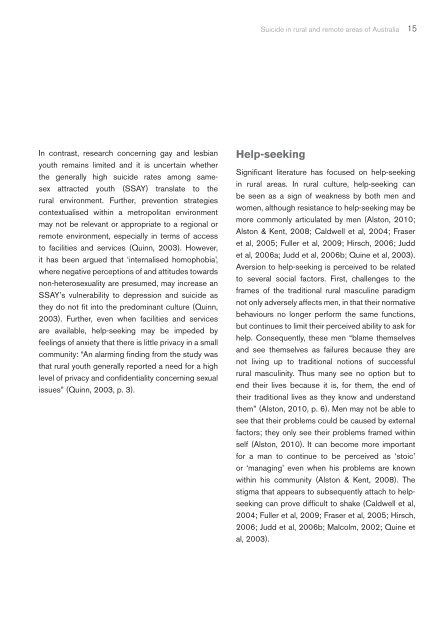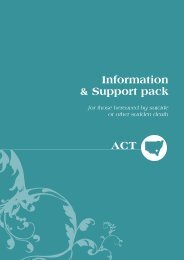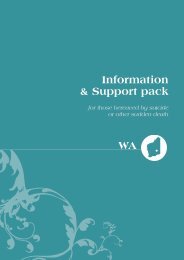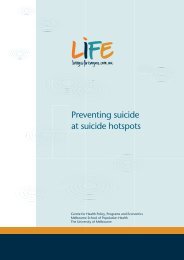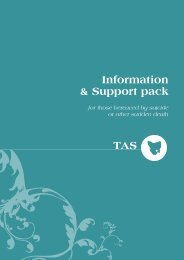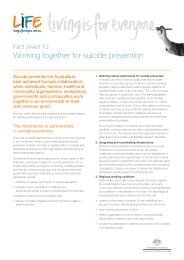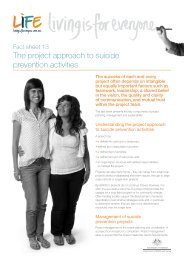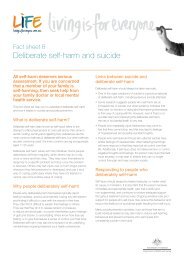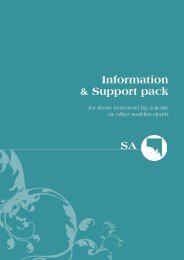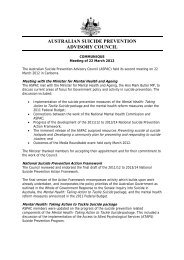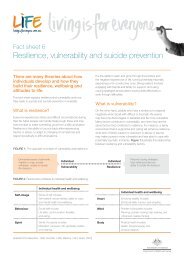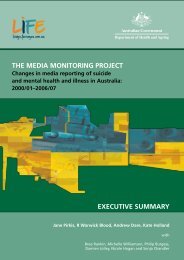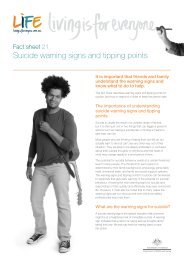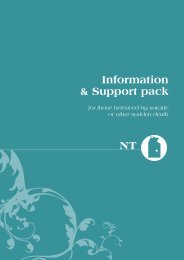SUICIDE in RURAL & REMOTE AREAS of AUSTRALIA - Living is for ...
SUICIDE in RURAL & REMOTE AREAS of AUSTRALIA - Living is for ...
SUICIDE in RURAL & REMOTE AREAS of AUSTRALIA - Living is for ...
Create successful ePaper yourself
Turn your PDF publications into a flip-book with our unique Google optimized e-Paper software.
Suicide <strong>in</strong> rural and remote areas <strong>of</strong> Australia 15<br />
In contrast, research concern<strong>in</strong>g gay and lesbian<br />
youth rema<strong>in</strong>s limited and it <strong>is</strong> uncerta<strong>in</strong> whether<br />
the generally high suicide rates among samesex<br />
attracted youth (SSAY) translate to the<br />
rural environment. Further, prevention strategies<br />
contextual<strong>is</strong>ed with<strong>in</strong> a metropolitan environment<br />
may not be relevant or appropriate to a regional or<br />
remote environment, especially <strong>in</strong> terms <strong>of</strong> access<br />
to facilities and services (Qu<strong>in</strong>n, 2003). However,<br />
it has been argued that ‘<strong>in</strong>ternal<strong>is</strong>ed homophobia’,<br />
where negative perceptions <strong>of</strong> and attitudes towards<br />
non-heterosexuality are presumed, may <strong>in</strong>crease an<br />
SSAY’s vulnerability to depression and suicide as<br />
they do not fi t <strong>in</strong>to the predom<strong>in</strong>ant culture (Qu<strong>in</strong>n,<br />
2003). Further, even when facilities and services<br />
are available, help-seek<strong>in</strong>g may be impeded by<br />
feel<strong>in</strong>gs <strong>of</strong> anxiety that there <strong>is</strong> little privacy <strong>in</strong> a small<br />
community: “An alarm<strong>in</strong>g fi nd<strong>in</strong>g from the study was<br />
that rural youth generally reported a need <strong>for</strong> a high<br />
level <strong>of</strong> privacy and confi dentiality concern<strong>in</strong>g sexual<br />
<strong>is</strong>sues” (Qu<strong>in</strong>n, 2003, p. 3).<br />
Help-seek<strong>in</strong>g<br />
Signifi cant literature has focused on help-seek<strong>in</strong>g<br />
<strong>in</strong> rural areas. In rural culture, help-seek<strong>in</strong>g can<br />
be seen as a sign <strong>of</strong> weakness by both men and<br />
women, although res<strong>is</strong>tance to help-seek<strong>in</strong>g may be<br />
more commonly articulated by men (Alston, 2010;<br />
Alston & Kent, 2008; Caldwell et al, 2004; Fraser<br />
et al, 2005; Fuller et al, 2009; Hirsch, 2006; Judd<br />
et al, 2006a; Judd et al, 2006b; Qu<strong>in</strong>e et al, 2003).<br />
Aversion to help-seek<strong>in</strong>g <strong>is</strong> perceived to be related<br />
to several social factors. First, challenges to the<br />
frames <strong>of</strong> the traditional rural mascul<strong>in</strong>e paradigm<br />
not only adversely affects men, <strong>in</strong> that their normative<br />
behaviours no longer per<strong>for</strong>m the same functions,<br />
but cont<strong>in</strong>ues to limit their perceived ability to ask <strong>for</strong><br />
help. Consequently, these men “blame themselves<br />
and see themselves as failures because they are<br />
not liv<strong>in</strong>g up to traditional notions <strong>of</strong> successful<br />
rural mascul<strong>in</strong>ity. Thus many see no option but to<br />
end their lives because it <strong>is</strong>, <strong>for</strong> them, the end <strong>of</strong><br />
their traditional lives as they know and understand<br />
them” (Alston, 2010, p. 6). Men may not be able to<br />
see that their problems could be caused by external<br />
factors; they only see their problems framed with<strong>in</strong><br />
self (Alston, 2010). It can become more important<br />
<strong>for</strong> a man to cont<strong>in</strong>ue to be perceived as ‘stoic’<br />
or ‘manag<strong>in</strong>g’ even when h<strong>is</strong> problems are known<br />
with<strong>in</strong> h<strong>is</strong> community (Alston & Kent, 2008). The<br />
stigma that appears to subsequently attach to helpseek<strong>in</strong>g<br />
can prove diffi cult to shake (Caldwell et al,<br />
2004; Fuller et al, 2009; Fraser et al, 2005; Hirsch,<br />
2006; Judd et al, 2006b; Malcolm, 2002; Qu<strong>in</strong>e et<br />
al, 2003).<br />
GriffithBook FINAL 20/09.<strong>in</strong>dd 15<br />
15/11/12 4:28 PM


